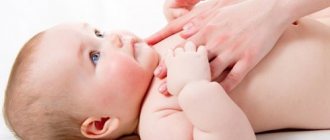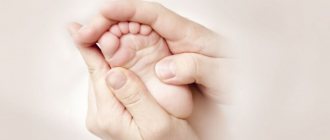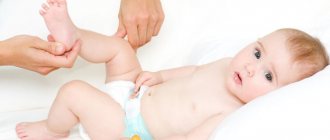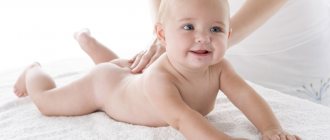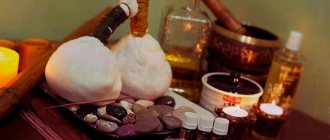Massage for a newborn from 0 months at home
In the first months of life, many basic skills are laid, the character and psychological portrait of the baby, his understanding of the world begins to form. He learns to react to what is happening, to express emotions. The child’s growth and development proceeds at a rapid pace: every day is equal to a new mastered skill, movement, reaction, sound or smell. The task of parents is to support the baby, teach him to perceive the world correctly, prepare his muscles and ligaments, relax and calm him down. Correct and timely massage copes with all these tasks.
Restorative massage for infants
Almost every newborn baby is born with strong muscle tone. Don't be alarmed - this is completely normal. This condition is a consequence of the fact that the baby spent nine long months in his mother’s tummy in almost weightlessness.
Massage for infants helps eliminate hypertension. Also, these manipulations help strengthen the baby’s body. During the massage, blood flow increases and muscles warm up. All this allows you to increase your immunity and avoid many diseases in the future.
When should you do a restorative or relaxing massage for infants?
Most doctors (neonatologists, pediatricians and neurologists) recommend starting such manipulations already in the first month of the baby’s life. However, this is not always possible. If you go to a specialized medical institution, you will most likely be faced with a pre-registration for a massage for infants. Don't want to wait? In this case, you can carry out some manipulations yourself and not waste precious time.
Massage for infants is prescribed to almost everyone. In this case, it does not matter at all whether the child has any deviations. During the first year of life, doctors recommend a total of three courses of massage with short breaks. All this will help the child adapt and quickly acquire some skills.
What time is optimal
Every child, like an adult, is individual. Some are early risers, some are night owls. Before you begin the procedure, take a closer look at your baby, pay attention to what time (morning, afternoon or evening) he is most cheerful and active. This way you can choose the right time.
During the session, the child is capricious, cries, screams if he:
- Wants to sleep. Don't disrupt the established routine! If after 15 minutes the child begins to sleep during the day, and you decide to start a massage, it is unlikely to be beneficial. The period of wakefulness is the best time for procedures. Children who have had enough sleep are usually calm and feel good.
- Hungry. There is a misconception that massage should be done on an empty stomach. In fact, this is not true. If we are talking about small breastfed babies who eat often. Feed your baby half an hour to an hour before doing it. Wait until the baby burps air, wait a little, and proceed. Don't worry if your baby spits up during or after the procedure. After 45 minutes, the baby can be fed again.
Does your little one have a hard time falling asleep in the evening? Then an evening massage performed after bathing will be ideal for him. It will help your child relax and fall asleep faster.
Important! The room must first be ventilated to 18°C -22°C. But the massage therapist’s hands should be warm.
Conditions
So, you have decided to do a baby massage at home. What will it take? First, you need to decide on the room. It should be light and spacious. Before the session, the room must be ventilated. However, it shouldn't be cold there. The most suitable temperature is 24-26 degrees.
It is also worth choosing a surface. It shouldn't be very soft. If you have a changing table, then use it. Otherwise, give preference to the most ordinary kitchen table. Place a blanket folded several times on a hard surface and cover it with a diaper.
You need to decide on cosmetic products for massage. Prepare rich baby cream or oil in advance. If your baby is prone to an allergic reaction, you can use the most common fragrance-free powder.
Before starting the session, carefully examine your baby and make sure of the following:
- the child is full;
- the baby does not want to sleep;
- the baby does not have a fever, runny nose or sore throat;
- the baby has no medical contraindications for the procedure.
How often can I do it?
Massage is part of daily baby care. Until 2 months, the mother strokes the back, tummy, and slightly kneads the muscles of the arms and legs.
Closer to 2.5 months, movements in the joints and patting are added. Massage is carried out every morning after feeding and washing.
If the mother wishes, the procedure can be performed at another convenient time. Regularity and systematicity are important; the baby will get used to it and will happily respond to his mother’s loving touches. If the massage is entrusted to a specialist, then it is recommended to undergo sessions in courses every few months.
Usually the first course begins at the age of 2-3 months and lasts about 10 days. The subsequent course is timed to the age of six months, when the baby is preparing to sit up independently. The final stage is carried out at the age of 10-11 months before walking begins.
Dr. Komarovsky calls massage an excellent tool for communication between baby and mother.
How to massage a baby yourself?
Massage for infants with hypertonicity involves a step-by-step treatment of the whole body. You need to move from bottom to top, without missing a single part. First, you should stretch your fingers and feet, then treat your legs. Next comes the turn of the tummy and arms. You need to move in the same order when you turn the baby over.
Remember that during all manipulations you should not put too much pressure on parts of the body. Perform only stroking and smooth movements. The baby's muscles are still very weak, and the bones are fragile and more like cartilage. They are very easy to damage. You should also avoid parts of the body such as the neck and head area. The only exceptions are those cases when you have a medical education and know where exactly certain points of influence are located.
Fingers, feet and legs
Lubricate your baby's hands and feet with your chosen product. After this, take one finger at a time and turn it slightly. Treat all limbs in this way and move on to the foot.
Draw something like an infinity sign from the heel to the toes. Press alternately on the heel, then on the area between the second and third toe. You will see how the baby reflexively squeezes and unclenches his leg.
Next, move on to your calves. They need to be gently massaged in the muscle area and stroked. Hips are treated in a similar way. However, you should not touch the inside. There are many important arteries and veins there that are not yet protected by either muscle or fat.
Tummy and chest
Massage for infants (2 months) helps not only relieve tone and strengthen the body, but also relieves colic. However, it must be done correctly. Lubricate the abdominal area generously and begin making circular movements clockwise from the navel. After this, use gentle pinching movements to massage the umbilical ring. This will help strengthen the muscles in that area.
Make several gathering movements from the barrels to the center of the tummy. Try to avoid the liver and spleen areas. These organs are too close to the skin and can be injured.
Massage for infants (3 months and older) does not involve treatment of the mammary glands. This condition especially applies to girls. It is better to skip this area completely.
Do all kids need this?
Does a child need a massage if he is healthy? Doctors answer unequivocally - yes! This is an effective method of treating existing diseases, but also preventing their occurrence, especially in the first year of life.
Due to the high degree of children's susceptibility to influences through the skin, massage:
- helps stimulate normal organ formation;
- has a beneficial effect on the central nervous system;
- assists in speech development;
- balances muscle tone;
- strengthens the heart and blood vessels;
- improves digestion, reduces pain from colic;
- has a positive effect on the emotional and physical state of the baby;
- improves sleep;
- reduces moodiness.
The therapeutic type of procedure is prescribed for medical reasons. For a healthy baby, classic, preventive or relaxing types are useful, which are performed even on infants.
Hands and shoulders
Apply the massage product to the indicated area and begin stroking the shoulders. Gradually work your way down your arm, treating each area of skin. Pay special attention to each finger. Stretch your limbs alternately, bending and straightening them.
Massage for 6-month-old infants involves the following manipulation: after treating the hands, place your thumbs in the baby’s palms; when the baby grabs them, pull them slightly towards you - the baby will try to sit up on their own, tensing the abdominal muscles.
It is better not to touch your neck at all, especially if you do not have a medical education. Leave this place for specialists to work. This will help you avoid accidental joint damage and complications.
MASSAGE FOR INFANTS
General massage can be performed on children from one month of age. In some cases, according to indications, it is carried out at an earlier date (for example, abdominal massage for flatulence). Massage, like physical exercise, is recommended to be performed no earlier than 40-60 minutes after feeding. It is not recommended to massage before feeding. On each part of the child’s body, massage movements are performed 4 to 6 times.
FEATURES OF CHILDREN'S MASSAGE
A powerful tactile stimulus, such as massage, is especially important in infancy: it has a significant impact on the development of positive emotions and the formation of motor reactions.
Stroking, a light pat on the cheek causes a smile in the baby for the first time in his life, when other stimuli: visual (an adult’s smile) and auditory (affectionate conversation), are not always able to stimulate it. Pediatricians call this a physiological smile, as opposed to a smile in response to treatment. Psychologists who study the development of speech in children know that the first manifestations of speech (humming) more often occur in response to stroking the legs and abdomen, while other forms of communication with adults do not cause revival in the child.
This is explained by the fact that the conductive pathways of the skin analyzer mature earlier than all others (visual, auditory) and are ready for birth. Therefore, a child in the first months of life is most accessible to exposure through the skin; touch causes not only emotional, but also certain motor reactions.
The human brain grows and develops solely through its use. The more often the sensory and motor endings of the nerve cells of the brain are activated at a given time, the larger the volume the brain occupies during its growth. In this regard, brain development is no different from the growth of muscle tissue through exercise.
BABY MASSAGE 1-3 MONTHS
TARGET . Balancing the tone of the flexor and extensor muscles of the arms and legs. To do this you need the following:
1. frequent communication and affectionate conversation with the child,
2. absence of restrictive movement of tight swaddling of the baby,
3. frequently placing the baby on his stomach,
4. warm daily baths and swimming,
5. light stroking massage of the whole body,
6. stimulation of the child’s active movements associated with the work of the extensor muscles. For this purpose, the main motor fund of this age is used - innate reflexes (food, protective and defensive, reflexes of the position and location of body parts). The last reflex can be used to teach children a free posture during sleep. The “curled up” position, lying on your side with your arms pressed to your chest and legs pulled to your stomach, does not provide sufficient relaxation to the muscles and subsequently leads to poor posture.
Observations have shown that the free position of the legs depends on the position of the arms: if a child, lying on his back, puts his hands behind his head, then the legs straighten freely. If the baby presses his arms to his chest, then his legs, as a rule, are pulled towards his stomach. During wakefulness, you need to place your baby on his stomach more often. This position will allow him to raise and hold his head earlier, turn it in different directions, and observe the world around him.
It has been noticed that children who are used to sleeping on their stomachs are less likely to suffer from the accumulation of gases in the intestines and begin to hold their heads up earlier.
- Hand massage: stroking, 6-8 movements. The masseur places the thumb of the hand in the child’s hand and holds the handle. Stroking is carried out along the inner surface from the hand to the shoulder. The left hand is massaged with the left hand, the right hand with the right, Fig. 82.
- Lifting from a supine position (no more than 1 time). Do not take your head off the massage table.
- Foot massage. Stroking is performed along the posterior outer surface in the direction from the foot to the thigh. On the left leg, the technique is carried out with the right hand and vice versa, Fig. 83.
Rice. 82 Fig. 83
- Laying on the stomach. If the child does not hold his head in this position, then it is turned on its side in one direction and then in the other direction. The duration of the manipulation is 5 – 10 seconds.
Reflex exercise “frog” 2 – 3 times. Bend your legs, spreading your knees to the side. Carefully, without touching the soles, grasp the back of the child’s feet. Then lightly press your thumbs on the soles of your feet at the same time. The baby reflexively straightens his legs, pushing off vigorously and moving forward. The massage therapist's hands should provide good support for pushing the child. Keep your feet on the back side, otherwise the baby may slip off the table.
· Back massage. Stroking from the buttocks to the head using a combined technique. Ironing with rake-like stroking, fig. 84.
Rice. 84 Fig. 85
Spinal extension. Reflex exercise (Galanta reflex), 2 – 3 times. The child lies on his side. Holding the baby by the legs with one hand, run two fingers of the other hand along the spine from bottom to top. The baby arches his back.
·
Abdominal massage, fig. 85. Circular stroking in a clockwise direction. Counter stroking - the left hand moves from below to the right hypochondrium, the right hand from the left hypochondrium from top to bottom. Stroking the oblique abdominal muscles, fig. 85. The palms of both hands move from the lower back towards each other, the fingers connect above the navel. Repeat circular stroking.
Rice. 85 Fig. 86
· Exercise to strengthen the abdominal muscles, 2 – 3 times. During this exercise, make sure that the child rests his feet on the massage therapist’s stomach.
· Foot massage, fig. 86. Holding the child’s leg with one hand in the shin area, with the other hand, use the pad of the thumb to stroke the sole of the foot in a circular motion. Then, without changing the position of the hands, bend and straighten the child’s leg at the ankle joint several times.
· Reflex exercise for the feet. Hold the child's foot with the tip of the thumb and press the sole at the base of the toes. The child bends his fingers. Then, with pressure, run your thumb along the outer edge of the foot from the little toe to the heel. The baby reflexively straightens his fingers.
· Breast massage. Stroking with both hands from bottom to top and to the sides. Then, from the middle of the chest, arm movements go down and to the sides, i.e. The lateral surfaces of the chest are stroked. Grasp the child's chest in the lower part, and lightly squeezing, very gently, softly and rhythmically make a labile continuous vibration.
· Shaking hands. You can do this movement alternately with each hand or with both hands together.
· "Embryo". The child lies on his back. Fold your arms crosswise across your chest, pull your bent legs toward your stomach (knees should be spread wide apart), tilt your head toward your chest. Holding your arms and legs with one hand, with the other we support your head under the back of your head. In this position, we rock the child in different directions: back and forth, to the sides and in a circle.
· Reflex “walking”. We hold the baby under the arms in an upright position face to face. We touch the child’s feet to the surface of the table. We lead the baby, slightly tilting him forward.
· Swinging on the ball in different directions. The child lies on his stomach. The knees are spread wide apart. The arms lie freely in front of the chest. Hold the baby in the lumbar region.
BABY MASSAGE 3-4 months
TARGET. Normalization of leg tone, development of the first skills in changing body position, development of manual skill. This is facilitated by:
1. frequent communication with the child,
2. inserting toys that are easy to grip into the handles,
3. warm baths and swimming,
4. more energetic massage, a new rubbing technique is introduced.
5. active movements based on innate reflexes, especially body posture reflexes
6. passive exercises with vibration
7. turn from back to stomach
· Hand massage. Stroking, 5-6 movements. Ring rubbing, 2-3 times. Stroking, 2-3 times.
· Crossing your arms over your chest. Spread the child's arms to the sides. Shaking the arms, cross them on the chest 6-8 times. The pace of movement is slow.
· Foot massage. Stroking, 2-3 times. Ring rubbing, 5-6 times. It is done with both hands at the same time, the hands move in opposite directions. Stroking, 2-3 times.
· “Sliding steps” or “stomping.” Lightly shaking the child's leg, we try to straighten it while sliding our foot along the surface of the table. If straightening the legs is difficult for the child, you can simply “stomp” your feet on the surface of the table.
· Turn onto your stomach 2-3 times in each direction. The child's legs are grabbed with a "fork". The movement comes from the pelvis. When turning the baby from his back to his stomach, hold him a little on his side.
It is especially important to instill the skills of correct turning in weakened and premature children.
· Massage of the back, buttocks. Combination stroking (ironing with rake-like stroking). Rubbing with fingertips. The fingers move towards each other. If circular rubbing is performed clockwise with one hand, counterclockwise with the other.
Rubbing the buttocks is done with one hand, and the pelvic area is fixed with the other. Stroking.
· Extension of the spine in a position on the side, 2-3 times (Galant reflex).
· Swimmer position. Once. Holding your legs with a “fork” and lifting them, place your palm under your stomach. Raise the baby above the table. The child lies horizontally on the palm. His head and upper body are raised, his spine is straightened.
· Abdominal massage. Circular, counter stroking, oblique abdominal muscles. Rubbing with fingertips in diverging circles around the navel, along the rectus abdominis muscles. Stroking.
· Raising the head and torso from a position on the back (incomplete sitting), 2-3 times. The child holds onto the masseur's thumbs. By pulling the arms, we raise the child’s head and upper body, without bringing it to a sitting position. Then slowly and carefully place the baby on either the left or the right side so that the baby does not hit the back of his head.
· Foot massage. Stroking. Rubbing the sole of the foot with the pad of the big toe, the outer edge of the foot from the toes to the heel. Tapping the foot with the back of the index and middle fingers, applying light and rhythmic blows.
· Reflex exercise for the feet (flexion and extension).
· Reflex “walking”.
· Breast massage. Stroking. Pressing our fingers on the child’s chest, we simultaneously move our hands from the middle to the sides of the chest. Essentially, we perform labile continuous vibration on the chest.
· Boxing exercise for arms. The thumbs are in the child's hands, the rest lightly hold his hands. We alternately bend and straighten the baby’s arms. When extending the arm, lift his shoulder a little, slightly turning the child from side to side.
· Exercises on the ball. The child can swing on an inflatable ball while lying on his stomach and on his back.
BABY MASSAGE 4-6 months
TARGET. Finally normalize the tone of the leg muscles, develop the support reaction of the feet, teach the child to hold objects, and develop the rhythm of movements. For this use:
· affectionate communication with the child during classes, rhythmic counting,
· active exercises based on the baby’s innate reflexes and desire to sit down, do not rush to sit the child down, covering him with pillows.
passive exercises
Age-appropriate toys
· swimming,
· full body massage, including more intense techniques - kneading.
Hand massage. Stroking. Rubbing, Stroking
1. Crossing your arms over your chest, 6-8 times.
2. Foot massage. Stroking, Rubbing on the outer surface. Kneading with one hand, felting. Stroking.
3. “Sliding steps”, 5-6 times. Change the pace. First - slowly, then - faster, at the end - slowly again.
4. Simultaneous flexion and extension of the legs with light pressure on the stomach. The knees are spread wide apart. 5-6 times.
5. Turns from back to stomach. The child turns almost independently, without hand support.
6. Massage of the back and buttocks. Stroking. Rubbing, you can add sawing. Kneading: rolling, shifting paravertebral muscles. In the area of the buttocks in an m-shaped direction, pinching and kneading with the pads of four fingers. They use percussion techniques - beating, chopping. You can pat the upper part of the back with your palm.
7. “Hovering” on the stomach, once. Palms under the stomach, thumbs on the sides at the level of the lower ribs. We lift the child above the table in a horizontal position, supporting him under the stomach. The child rests his feet on the massage therapist’s chest.
8. Abdominal massage. Stroking. Trituration. Pinching around the navel, finger shower. Stroking.
9. Sit down with a deflection of the spine, once. By lightly pulling the hands, we encourage the child to raise his head and upper body, and sit the baby down. Holding the baby's arms up and in front with your left hand with your other hand, use your index and middle fingers to run along the spine from bottom to top.
10. Foot massage and exercises based on reflexes. Stroking. Trituration. Effleurage. Flexion and extension of the feet.
11. Dancing. Make sure your child does not stand on tiptoes.
12. Breast massage. Stroking. Vibration. Stroking.
13. "Boxing" Circular movements with your hands. This is a difficult exercise. Do it slowly, smoothly and only if the baby has already mastered simpler movements: crossing his arms on his chest, spreading them to the sides, “boxing”.
14. “Hovering” on your back. Grasp the child by the side of the body at the level of the lower chest. It is better to do this from the side of the head. Raise the baby to a horizontal position. In response to this position, the child's head tilts forward, and all the muscles on the front surface of the body tense.
15. Crawling on all fours. Bend your legs under your stomach and hold your baby in this position. Then we remove our hands - the child stands on his own.
BABY MASSAGE 6-9 MONTHS
A good indicator of a child's development is his ability to crawl. It is advisable that children learn to climb before sitting down and standing up.
TARGET. Teach a child to crawl on all fours, develop coordination and rhythm of movements, and develop understanding of speech. To do this you need:
1. Communicate affectionately with your child frequently, using short, precise verbal instructions during activities,
2. give the child the opportunity to move freely outside the playpen or crib,
3. introduce new, more complex movements in coordination.
There is no need to massage the limbs.
§ Crossing your arms over your chest.
§ Exercises for the legs: simultaneous and alternate flexion and extension of the legs.
§ Turn from back to stomach.
§ Back and buttock massage. Stroking. Trituration. Kneading. Impact techniques. Tingling in the upper back and buttocks.
§ Crawling on all fours. Make sure your hands are well open.
§ Abdominal massage. Stroking. Trituration. Pinching or finger showering around the navel. Stroking.
§ Sitting down. If the baby does it without difficulty, then you can sit down with one hand. Hold the baby's legs with your other hand. Slowly place the baby on his side. When the child is sitting, you can run your fingers along the spine from bottom to top, causing the back to straighten.
§ Circular movements with hands.
§ Foot massage: stroking, rubbing, tapping, bending and straightening the feet.
§ Raising straightened legs simultaneously and alternately.
§ Raising the torso from a position on the stomach. We hold the child's hands at ear level. We spread our straightened arms to the sides and raise them up. The baby’s feet rest against the masseur’s stomach. We continue to raise the child to a kneeling position. Later, at the end of the exercise, he can be raised to his feet.
§ Breast massage. Stroking. Vibration massage. Stroking.
§ Sitting down with bent arms, 1-2 times. Holding the child’s hands, we spread our arms shoulder-width apart and gently pull the child by the arms to encourage the child to sit down. When performing this exercise, the baby should raise his head and torso, pull himself up, bending his arms. If he does not do this, especially when his arms remain straight, then the exercise should be considered premature.
§ "Boxing".
§ “Wheelbarrow” - walking on hands. We lift the baby by the legs above the table, grabbing them with a “fork.” The arms are straightened and resting on the table. Use your free hand to support the baby's stomach. By slightly rocking forward, we encourage the child to move forward on his hands.
BABY MASSAGE 9-12 months
TARGET. Development of coordination of movements, training of strength and endurance, independence of the child.
To do this you need:
1. continue to use a set of exercises, as well as massage and swimming.
§ "Boxing". You can use the starting position while sitting. You can bend and straighten your child’s arms by placing rings or other easy-to-grip objects or toys in his arms.
§ Bending and extending the legs alternately at different paces, simulating walking and running.
§ Turn from back to stomach in both directions.
§ Back and buttock massage (see above).
§ Raising the torso in a prone position. Holding the embedded rings in the child’s hands, we spread his arms to the sides and up to ear level. The baby raises his head, then kneels down, then, leaning on one bent leg, stands up to his full height.
§ Bend forward, 2-3 times. The baby stands on the table with his back to the masseur’s stomach. With one hand we hold the baby’s legs at knee level, preventing bending. With the other hand, placed in the abdominal area, we support the torso. We ask the child to take out his favorite toy lying in front of him on the table. Without squatting, the baby bends down for the toy. Then, with difficulty, he straightens up.
§ Abdominal massage (according to the established scheme, see above).
§ Sitting down with support from one hand or independently, 1-2 times.
§ Squats, 2-3 times. The child stands firmly and moves his knees to the side when performing a squat.
§ Breast massage.
§ Circular movements with hands.
§ “Wheelbarrow” - walking on hands.
§ Walking with hand support. The child is taken from below at the elbows and, supporting him, is encouraged to step over with his feet. You can put your baby on your feet and walk with him.
§ Learning to crawl under a chair and crawl.
Abdominal exercises
Massage for infants (2 months) includes the following manipulation: take the baby by one arm and slightly pull it in the opposite direction - the baby will reflexively try to roll over, and you should help him with this.
Lubricate the baby's back with the product and gently stroke it. Massage your shoulders and lumbar region. After this, begin exercises for the hip joints. Remember that the baby should have no contraindications to such gymnastics. You can find out about this from your pediatrician or neurologist.
Bend your leg at the knee and move it to the side. Do a similar procedure with the second limb. The baby should take a frog pose. Don't worry about the baby being in pain. Babies at this age are very flexible and can make similar movements without difficulty.
When to start, recommended duration
This is a question many parents ask. In the maternity hospital, newborns, if healthy and full-term, are given a massage together with air baths already on the 2nd day of life. But after discharge, it is better to wait for the umbilical ring to heal - wrong actions can cause the development of an umbilical hernia.
For small children from birth to 3 months, sessions are performed daily, no more than 10-15 minutes per approach. You need to finish before the baby gets tired and starts to be capricious. If these conditions are met, the child will begin classes with pleasure the next day. Starting from 3 months and until the age of six months, the duration is gradually increased, reaching 30 minutes. The massage becomes more intense.
Attention! Before starting a massage for your child, consult with doctors - pediatrician, orthopedist, neurologist, as there are contraindications for performing it!
Vertical gymnastics
When all the baby’s muscles are stretched and warmed up, lift the baby up by the armpit area. Position the baby so that his feet touch the surface - the baby will begin to reflexively make walking movements. Babies after six months especially like this exercise. They get new sensations and are happy.
Pick up your baby and rock him from side to side. This exercise will help develop the functioning of the vestibular apparatus.
How to finish the massage?
Any type of gymnastics must be concluded correctly. The best way for this is water procedures. Remember that infants have an innate swimming reflex. However, it fades away around four months. If you want to go swimming with your baby, then you should start doing it as early as possible.
The temperature of the water for swimming after the massage should be 32-35 degrees. First, you should give your baby a bath, since his body can be very slippery due to the special product. After this, let the baby enjoy some water. Move it forward and back, make circular movements with your small body. If desired, you can use a special circle that is placed around the baby’s neck.
If you refuse water procedures, then you can give preference to a large ball called a fitball. You can perform a variety of exercises on it: rocking, vibration, circular movements. Not only will your baby enjoy all this, but it will also develop his sense of balance and vestibular apparatus.
After all the procedures performed, it is necessary to feed the baby. Most likely, at this moment the child will fall asleep in a sweet dream. You shouldn't wake him up. Such exercises greatly tire the baby’s still fragile body. Remember that after the massage the baby’s body is warmed up, but during sleep it cools down. Therefore, it is worth covering the child well so that he does not catch a cold.
Basic rules and features
You need to know about the nuances that must be observed during a massage session.
- The room temperature should be between 18 and 22 degrees. If you deviate from the accepted norm, you must either ventilate the room or, conversely, heat the office or room.
- For massage it is best to use a special couch. If there is none, manipulations should be carried out on a perfectly flat surface, the dimensions of which do not interfere with the baby’s movements and turns. It should be covered with a flannel blanket, diaper or oilcloth.
- All necessary tools should be at hand. This will help you not to be distracted from the session.
- It is strictly forbidden to do a massage with a long manicure or protruding nail decorations. During the procedure, all jewelry from the hands (rings, bracelets, watches) must be removed so as not to injure the small child.
- It is necessary to choose the right time for the massage. The baby should be in a good mood, cheerful and cheerful. It is best to do the procedure one hour after feeding.
- During the massage, you need to maintain a dialogue with the baby so that his mood remains elevated.
Contraindications to massage are various diseases of the blood and cardiovascular system, ARVI. It is also worth postponing the session if the baby’s body temperature is elevated, as well as if bones are fragile. It is necessary to refuse massage if the skin of a small child is affected by ulcers or boils. If your baby has a heart defect, you must consult a cardiologist before starting the course.
If the above conditions are met, massage will bring exceptional benefits to the baby and will contribute to the better development of his body.
What benefits does massage give to a baby?
After a few sessions, you can already see a positive effect. The baby will begin to sleep better and longer, become calmer and more confident. The baby will no longer be afraid of his movements. Many children acquire a good appetite and gain weight better after such courses.
In addition, massage will strengthen the immune defense and relieve the child of increased tone. The effect of the work done lasts for an average of 3 months. After this time, you can repeat the gymnastics course.
My steps
- 1990-1998 School No. 1804 Moscow
- 1998-2002 MC RAMS Nursing (qualification Nurse)
- 2002-2004 Institute named after. Sklifasovsky department Cardiac surgery
- 2009-2010 Russian Scientific Center for Restorative Medicine and Balneology (Moscow)
- 2010-2012 Massage nurse, preschool educational institution No. 1875 Moscow
- 2012-2021 Massage therapist, Children's city clinic No. 61, Moscow
- 2017 Completed advanced training course Speech therapy massage
- 08/2017 Physiotherapeutic diagnostics Vojte, St. Petersburg European methods of rehabilitation
- 10/2017 Block “A” BOBAT therapy St. Petersburg European methods of rehabilitation
- 2018 Kinesio taping “Academy of Therapeutic Taping” Kiselev D.A
- 2019 Therapeutic kinesiotaping “Academy of Therapeutic Taping” Subbotin F.A.
